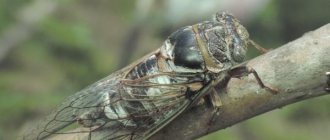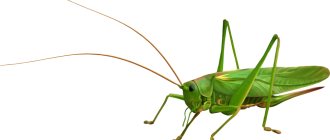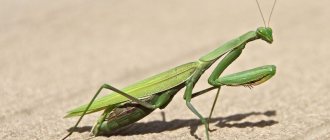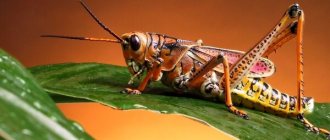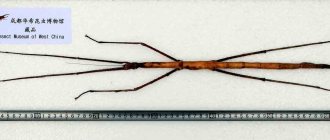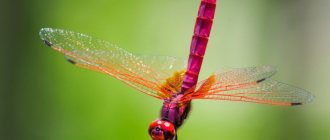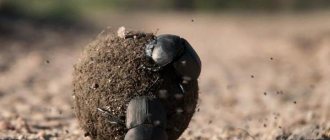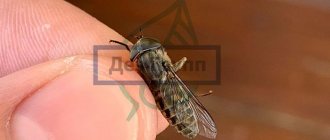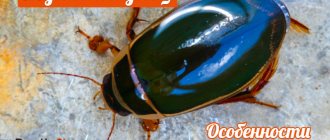Who are they and do they cause harm?
- Fact:
The cicada (an incomprehensible “cross between” a fly and a grasshopper) belongs to the family of hemipteran insects. - Fact 2:
And Russian representatives of the common leafhopper are no more than 10 cm with a body of 5 cm. - Fact 3:
An adult specimen lives an unremarkable 2-3 months, quite average for many insects - Fact 4:
The cicada sounds we hear are males.
For many, the singing of cicadas is a romantic and melodic accompaniment to a quiet, warm summer night. But homestead owners don’t like night music at all. After all, it indicates the presence of cicadas - voracious pests that can ruin all the work on growing the future crop.
Description
What does a cicada look like? In appearance, it most closely resembles a moth with transparent membranous wings (as seen in the photograph), of which one pair is longer than the other. The head of an adult cicada is short, the eyes are faceted and convex.
Cicada - insect photo:
After the adult insect undergoes its first molt, it will have three additional simple ocelli , forming a triangle. The cicada's head also contains organs of touch - small, segmented antennae. The oral apparatus is represented by a proboscis .
Depending on the species of the cicada (there are 2,500 species on the globe), the color of its wings can be more or less saturated. The cicada has three pairs of legs , different in structure. The front pair is equipped with wide “hips” and spines, the middle pair is less massive, and the third, longest pair of legs is designed for jumping.
Cicadas are not the only insects that live in summer cottages and vegetable gardens. We have prepared for you a series of articles about the most common pests. Read all about the Colorado potato beetle, the May beetle, the mole cricket, ants, spider mites, moths, locusts, slugs, cutworms, aphids and thrips.
Scientists don't yet know how they tell time
Although experts speculate that periodical cicadas emerge only every 13 or 17 years to avoid predators, because they are slow to mature and because of the historical need for long juvenile developmental stages, methods for tracking the insects' timing have not been developed for a long time. One 2002 study found that they might be using more than just their body clocks to tell time so accurately—they might be using trees ().
In the study, the researchers transplanted 15-year-old to 17-year-old cicada nymphs under a tree whose flowering cycle had been altered so that it could occur twice per season. When the tree flowers, it produces high levels of sugar and protein, determined by the cicadas feeding on its roots. The nymphs appeared a year earlier, suggesting that they keep track of time by counting the seasonal cycles of their host.
Insect size
Not the largest species of cicadas live in Russia. The length of our common cicada (Lyristes plebeja) together with the elytra is 5 cm, and the wingspan is 10 cm. Representatives of other species of cicadas from our area reach a length of 2 - 4.5 cm .
Tropical cicadas in size . For example, the wingspan of the Indonesian royal cicada is 18 cm!
Their songs are loud like chainsaws
Those who live in cicada-prone areas know that weddings and other outdoor parties should be planned during the active season due to the insects' deafening songs. Only the males produce a deafening chirping sound - they do this by rubbing their wings together and using a special organ on their exoskeleton called the tymbal organ, which creates a series of rapid clicks. They make two sounds: one to attract mates and the other to scare away predators.
Their songs can reach 120 decibels - as loud as a chainsaw and even louder than live rock music - and can be heard up to 1 mile away. Naturally, a group of singing cicadas is called a choir (,).
Life cycle
How do they reproduce? Cicadas reproduce by eggs. After the male leafhopper fertilizes the female, he dies. The females still have to lay eggs . At the end of their abdomen there is a serrated ovipositor. The insect pierces or cuts the plant with it and lays eggs in the hole. At one time, the female can lay up to 400-600 eggs . Favorite oviposition sites:
- soft tissue of stems and leaves;
- root parts of plants (including winter cereals);
- carrion.
After 30-40 days, the mature larvae will fall out of the eggs onto the ground and burrow into the soil. And quite deeply and for a long time . Underground, cicada larvae often climb to a depth of 1 m.
Cicada larva - photo:
They spend most of their lives underground
Eriko Koga/Getty Images
Cicadas hatch above ground about 6 to 10 weeks after eggs are laid in cracks and holes in trees. They immediately fall and burrow 30 centimeters into the ground, where they remain for up to 17 years. While underground, they molt rather than pupate over five instars (growth cycles) ().
The greatest mortality occurs during those early stages of life when nymphs compete for feeding space underground ().
Features of development
In the depths of the earth, cicada larvae undergo a further cycle of life and development. They still bear little resemblance . The body length of the larvae is only 3-5 mm, but they have very powerful forelimbs with spines. With their help they dig the ground.
The larvae feed on the basal part of stems and plant roots , to which they firmly adhere with their mouthparts. Depending on the species and age, the color of the larvae varies, but in most cases their body is light in color.
Adult cicada larvae preparing to develop into an adult insect are called nymphs .
As soon as the soil warms up , the nymphs make their way up to its surface. There they make a burrow and wait for their transformation into a cicada. If the weather is rainy and the burrow may flood, the larva builds a drainage elbow out of the ground to protect itself from flooding .
Cicada nymphs emerge at the surface at the same time. Numerous predators await them here : foxes, lizards, hedgehogs. The mass emergence of nymphs makes it possible to save the lives of a large number of them. The number of larvae crawling up sometimes reaches about 370 individuals per 1 m².
They only appear when the ground reaches 18°C
The exact moment of the mass appearance of cicadas is very calculated. This only happens when the surface of the earth at a depth of 20 cm reaches approximately 18°C - and not a single degree higher or lower. When this temperature is finally reached, the nymphs know it is time to begin their journey up the mud chimney. This usually occurs shortly after sunset and they are high in the trees before most people even notice their arrival. The phenomenon can last for several evenings ().
Shedding
After its transformation into a cicada (usually in the month of May), the young insect is not yet able to fly . Therefore, a newborn cicada climbs some plant and waits for the old cover to fall off.
You can find out how a cicada molts by watching this short video:
, an adult cicada with the rudiments of wings is born Immediately after molting, the insect has a soft white body. After a few hours, the cicada will darken, but the body will harden only for 5-6 days.
Swarming is a survival strategy
It's unclear how many cicadas make up a single brood, but experts estimate there are billions of them. Their large bodies cover tree trunks. Their collective songs interfere with communication in the open air. Cicadas are famous swarming insects, but their synchronous emergence is actually a deliberate survival strategy called predator satiation. When a predator enters such a dense population, it quickly becomes saturated, increasing the chances of survival for a large percentage of the young (,).
How long does he live and where?
The lifespan of adult cicadas is only 2-3 months . However, the larval stage of development lasts several years, depending on the species from 2 to 17 .
Where do they live? The habitats of adult cicadas are trees and shrubs . Moreover, excellent camouflage allows these insects to remain unnoticed even at a fairly close distance.
Where are cicadas found in Russia? On the territory of Russia, cicadas are found in steppe and lowland forests, the middle zone, in the southern and northern parts of the country, and in the Caucasus.
Habitat
This insect lives almost all over the world where there are forests. That is why it often becomes food for geckos , chameleons , salamanders and even centipedes .
The vast majority of cicadas prefer warm climates, so in mid-latitudes only a species more adapted to such conditions is found - the mountain cicada (Cicadetta montana).
The northern border of its range runs through the Scandinavian countries, Leningrad and Pskov regions of Russia. Individual outbreaks occur in the south of Siberia and the Far East.
The most famous common cicada (Lyristes plebejus) is distributed in the subtropical regions of Europe, Russia and Ukraine: the Mediterranean, the Caucasus, Transcaucasia and the southern part of the Crimean Peninsula.
Forests of deciduous trees, especially oak and ash groves, are a favorite habitat for these insects.
From the forest-steppe in the south to the border of the taiga in the north, you can hear their chirping.
Representatives of the suborder Cycadidae are characterized by the fact that all their species are very similar to each other. Differences are observed in size and color
What does it eat?
What does a cicada eat, and what do its larvae eat?
Both larvae and adult cicadas feed on tree sap . Larvae drink juice using a segmented proboscis, and adult cicadas drink juice with a special mouth organ.
In addition to tree and shrub vegetation, food for cicadas :
- grains and oilseeds;
- legumes;
- sugar and starch crops;
- melons;
- colors.
Thanks to the power of their mouthparts, cicadas can extract sap even from deep plant tissues. The productivity of areas favored by the cicada is falling , and in connection with this it is necessary to competently take measures and means to combat the cicada.
Not only cicadas and other insects can cause irreparable harm to your plantings. On our website you can find useful information about other garden pests. Read all about wild rats, shrews, moles, bats and mice, gophers, wild hamsters. And also about ways to combat wireworms, locusts, whiteflies, sawflies and carrot flies.
They shed their skin
ViniSouza128/Getty Images
By late summer, cicadas shed billions of translucent skins called exuviae, leaving tree trunks covered in them even after their hosts die off. Shedding these skins is the first thing after leaving the ground. Once freed from the last shell, they must wait for their wings to fill with fluid and their new skin to harden. Only then will they be able to sing and mate during their tumultuous growth period.
What sounds does it make?
How do cicadas make sound? The sound that cicadas make is called chirping . Why do cicadas scream? The “singing” that is audible to us is produced by males , who have special convex membranes on the front of the abdomen - cymbals. Strong muscles attached to the membranes periodically increase or relax the tension of the convex part.
As a result of such vibrations, a loud chirping sound is formed, comparable in volume to the whistle of a steam locomotive.
Females can also make similar sounds, but they are inaudible to the human ear . The combined chirping of cicadas sometimes reaches about 100 dB.
When do cicadas chirp (crackle)? Cicadas need heat energy to produce their chirping sounds. Therefore, insects “sing” most actively on hot summer days . Although some species can vocalize at dusk and at night. This helps the cicadas protect themselves from daytime predators.
Why do cicadas sing? use chirping to attract females for mating . The tone of the “melody” is individual for each species, and females respond only to the roulades of “their” males.
You can learn how and why cicadas chirp by watching this scientific video:
"Musical talents" of cicadas
The cicada chirps we hear are the sounds made by the males. On the front of the abdomen they have special membranes of a convex structure. These are cymbals. When the strong muscles of the membranes contract, tension or relaxation of the cymbals occurs. The result of the vibrations is “singing” in the summer night, which puts you in a romantic mood.
To be fair, it must be said that the female also has a similar musical talent, but it is inaccessible to human hearing. In fact, cicadas are most active during the day when the heat is at its peak. It’s just that in the chorus of other sounds it’s not so noticeable and is perceived differently than at night, when it’s quiet and calm.
Why do cicadas sing? You ask? There are several reasons:
- During the day it helps protect against predators.
- Males attract females for mating.
The sound of cicadas, which is identical to the human ear, actually has its own tonality for each individual. And each female will respond only to “her own.”
The cicada does not harm humans directly. She doesn't bite, doesn't sting, doesn't scratch. “Only” destroys the results of his labor. And although the insect occupies an important place in the food chain, it cannot be left unpunished to cause mischief in the garden. It is unreasonable to rely on natural pest killers alone. So it won’t be long before you lose your harvest.
In literature
It is interesting that Krylov’s well-known fable “The Dragonfly and the Ant” is a free translation of La Fontaine’s fable “The Cicada and the Ant”. I think that the point is not ignorance of entomology, but that the fabulist deliberately adapted the text for residents of middle and northern latitudes. And, really: have you ever seen a dragonfly jump or sing?
Did you like the article? Have questions? Want to inspire the author? Leave a few comments! PS: Don't forget to visit my other website:
The entry was published in the Insects section. Bookmark the permalink.
Appearance
The common cicada is a large insect. Body length 30-36 mm, with wings 40-50 mm. The head is wider than the pronotum. There are two large compound eyes on the sides of the head, and three small simple ocelli in the center.
Common cicada: general view
The photo clearly shows red dots, which could be mistaken for sucking ticks, if not for their correct location.
Friends! This is not just an advertisement, but my, the author of this site, personal request. Please join the ZooBot group on VK. This is pleasant for me and useful for you: there will be a lot there that will not end up on the site in the form of articles.
Common cicada
The proboscis is long, reaching the posterior edge of the mesothorax. Together with the striped shield resembling a visor, it looks very intimidating.
Common cicada: bottom view
Males have a complex singing organ.
The color is black, the head and pronotum are patterned with yellow. The wings are transparent.
Common cicada: side view
The first time I grabbed a cicada, I was surprised that it felt much tougher than it looked. The wings, unlike fly wings, are so dense that at first it seems that you can cut yourself with them.
Lifestyle
The cicada fly feeds on plant juices, while the larvae feed on roots. They infect the plant in large crowds, causing significant damage to agriculture. After the larvae emerge from the ground, they quickly move towards the green part of the trees.
On a note!
For 1 sq. m. area can accumulate about 300 individuals.
In tropical countries, the emergence of a new generation of cicadas is a real feast for birds and many animals. After a few days, the well-fed enemies leave to digest protein food, and the remaining cicadas begin the mating season.
Males produce melodious, loud trills to attract females. The chirping is so loud that the sounds of dragonflies and grasshoppers fade in front of it. Residents of tropical areas compare the sound of a cicada fly with the roar of a chainsaw or the whistle of a steam locomotive. Noise has an irritating effect on the nervous system.
For the vast majority, the song is performed exclusively by the male; females silently mate and lay eggs so as not to attract enemies. The appearance with brown, green shades and transparent wings makes it easy to hide in the thickets of bushes and trees. Even with its impressive size, the fly is difficult to notice.
Interesting!
The source of the loud sound is at the end of the body. There is a membrane that is set in motion by the muscles, followed by a resonator that amplifies the chirping sound several times. The membrane vibrates about 600 times per second. In the tropics it is simply a deafening sound.
The mating season lasts about a week. After mating, the male lives for about 14 days, the female can live up to 2 months. During this time, it lays up to 2 thousand eggs. Local residents compare the appearance of adult larvae to an invasion of locusts that destroy everything in their path.
cicada fly
Varieties
The most famous of the two and a half thousand species of these pests belong to the family of leafhoppers.
Cicadas such as
- six-point,
- dark,
- striped,
- grape,
- club-shaped,
- roseanna,
- potato
Their structure, reproductive characteristics, character and food items are generally very similar and differ only in details.
Thus, the six-spotted leafhopper is yellow-green in color with six dark spots on its head. The overwintering phase consists of eggs; larvae appear from late April to early May. The development of this type of insect occurs in two or three generations.
The dark leafhopper has the highest level of danger as a causative agent of viral infection of cereals.
Males are brownish-black, females are yellowish. The transparent wings of females are marked with a brown spot.
Older larvae overwinter in cereal crops. The fledging and emergence of adult cicadas occurs much earlier than other species. Dark leafhoppers develop in two generations.
Nanotechnology
Psaltoda claripennis is a cicada, the surface of its wings is covered with microscopic spines. This surface kills bacteria that get on the wings. Scientists plan to use the discovery to create bactericidal materials.
Insects are interesting if you look at them carefully. Scientists still have many species of cicadas and other invertebrates to study. Many amazing discoveries have been made in science, and we still have to learn new secrets from the life of insects, their structure and behavior. Many arthropods lead complex lifestyles. Cicadas have an unusual structure and are record holders among insects. Moreover, they are very beautiful. Anyone who has seen the mass emergence of adult song cicadas from the last stage of the larval nymph will clearly not remain indifferent.
They are eaten by many predators - even humans
Ken Griffiths/Getty Images
Like many large-winged insects, cicadas are clumsy fliers, making them easy prey for birds and one of their largest predators, Sphecius grandis, the cicada hunter wasp. The appearance of cicadas is a holiday for lizards, snakes, rodents, raccoons and even fish, cats and dogs. These terrestrial predators are the reason why cicadas rush to climb high into trees when they emerge (,).
But people eat them too. Cicadas are known for their sweet taste, almost like shrimp, and are commonly deep-fried in Shandong cuisine in China. Even people in the US eat them raw, boiled, fried and stuffed.
